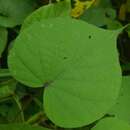pt-BR
nomes no trilho de navegação


Ipomoea turbinata ist eine Pflanzenart aus der Gattung der Prunkwinden (Ipomoea) aus der Familie der Windengewächse (Convolvulaceae). Die Art ist weltweit in tropischen Gebieten verbreitet. Nach R. Govaerts muss die Art Ipomoea muricata (L.) Jacq. heißen.
Ipomoea turbinata ist eine unbehaarte einjährige oder ausdauernde Pflanze. Die Stängel sind weit kletternd und weichborstig behaart. Die Laubblätter sind mit 4 bis 12 cm langen und unbehaarten oder weichborstig behaarten Blattstielen behaart. Die Blattspreiten sind häutig, eiförmig oder rund, 7 bis 16 cm lang und 6 bis 14 cm breit. Nach vorn sind sie zugespitzt, an der Basis sind sie herzförmig.
Die Blütenstände sind lockere dichasiale oder monochisale Zymen aus einer bis wenigen Blüten. Sie sind unbehaart und zur Fruchtreife stark verdickt. Die Tragblätter sind winzig. Die Kelchblätter sind nahezu gleichgestaltig, eiförmig langgestreckt, die äußeren sind 6 bis 7 mm lang und mit einer 4 bis 6 mm langen Granne besetzt. Die inneren Kelchblätter sind 7 bis 8 mm lang und mit einer kürzeren Granne besetzt. Die sich nachts öffnende Krone ist blass bläulich purpurn gefärbt und 5 bis 7,5 mm lang. Die Kronröhre ist schmal und zylindrisch und 3 bis 6 cm lang. Der Kronsaum ist trichterförmig oder tellerförmig.
Die Früchte sind 1,8 bis 2 cm lange Kapselfrüchte. Die Samen sind eiförmig, 9 bis 10 mm lang und 5 mm breit. Sie sind abgeflacht, schwarz und unbehaart.
Die Chromosomenzahl beträgt 2n = 30.[1]
Die Art stammt aus dem tropischen Amerika, ist aber weit in den tropischen Gebieten der Alten Welt verwildert. Oftmals wird sie als Zierpflanze kultiviert.
Sie wächst in flussnahen Wäldern, im Grasland und an Flussufern in Höhenlagen um 1000 m.
Ipomoea turbinata ist eine Pflanzenart aus der Gattung der Prunkwinden (Ipomoea) aus der Familie der Windengewächse (Convolvulaceae). Die Art ist weltweit in tropischen Gebieten verbreitet. Nach R. Govaerts muss die Art Ipomoea muricata (L.) Jacq. heißen.
Ipomoea muricata, also called lavender moonvine, is a climbing vine in the genus Ipomoea, the same genus that contains the various morning glory species and sweet potato. It is native to Central America, but now distributed widely across the tropics and subtropics.[1][2][3]
Ipomoea muricata is a fast annual climber, with funnel-shaped and white, reddish or lilac flowers, reminiscent of the color of lavender. The stems are twining and muricate. The leaf texture is glabrous, and its shape is ovate or orbicular.[1][2][4][3]
The various parts of the plant are used as food, medicine and poison by the peoples of its native and expanded range.[1] In the Indian state of Kerala, the plant is called clove bean or nithya vazhutana and the swollen peduncles are consumed, typically pan-fried or as a thoran.[4][3]
Ipomoea muricata, also called lavender moonvine, is a climbing vine in the genus Ipomoea, the same genus that contains the various morning glory species and sweet potato. It is native to Central America, but now distributed widely across the tropics and subtropics.
Ipomoea muricata es una especie fanerógama de la familia Convolvulaceae.
Enredadera herbácea, trepadora, voluble, anual, glabra o glabrada; tallo largo, ramificado; hoja ovada u orbicular, de 7 a 18 cm de largo, de 6 a 15 cm de ancho, ápice acuminado; inflorescencias con 1 a 3(5) flores; sépalos subiguales, oblongos a ovados, de 6 a 8 mm de largo, los exteriores gruesamente aristados, glabros; corola subhipocraterimorfa, de 5 a 8 cm de largo, blanquecina a violácea, purpúrea en la garganta; el fruto es una cápsula ovoidea, de 18 a 20 mm de largo, con 4 semillas, de 8 a 9.5 mm de largo, glabra.[1][2]
Especie de distribución pantropical debido a su cultivo como planta ornamental. En México se le ha registrado en la Depresión del Balsas, en la región de la costa y en la Sierra Madre del Sur, en los estados de Baja California, Sonora, Chihuahua, Michoacán, Guerrero y en Sudamérica, Asia, Filipinas y Tanzania.[1][2]
Se desarrolla en bosque tropical caducifolio y en zonas transicionales entre éste y el encinar. Prospera entre 500 y 1200 m de altitud. Florece de agosto a octubre.[1][2]
No se encuentra bajo ningún estatus de protección.
En El Salvador se conocen como pinito.[3]
|número-autores= (ayuda)
Ipomoea muricata es una especie fanerógama de la familia Convolvulaceae.
丁香茄(学名:Ipomoea muricatum)是旋花科番薯属的植物。分布在热带非洲、墨西哥、菲律宾、越南、印度、日本、缅甸、南美洲、锡金以及中国大陆的河南、湖南、云南、湖北等地,生长于海拔580米至1,200米的地区,多生在灌丛中以及河漫滩干坝,目前尚未由人工引种栽培。
天茄子(植物名实图考) 天茄(救荒本草)
丁香茄(学名:Ipomoea muricatum)是旋花科番薯属的植物。分布在热带非洲、墨西哥、菲律宾、越南、印度、日本、缅甸、南美洲、锡金以及中国大陆的河南、湖南、云南、湖北等地,生长于海拔580米至1,200米的地区,多生在灌丛中以及河漫滩干坝,目前尚未由人工引种栽培。